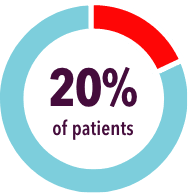Mycosis Fungoides may involve more than just the skin1
As the most common cutaneous T-cell lymphoma (CTCL) subtype, Mycosis Fungoides may be indolent with skin-only symptoms, but may progress to the blood, lymph nodes, and viscera

About 1 in 3 patients with Mycosis Fungoides
may experience progression within skin or to other compartments, including blood2,3

Up to 20% of patients with early-stage Mycosis Fungoides
may have blood involvement4
|
Blood involvement in Mycosis Fungoides: |
|
|---|---|
May be more common than you think4,5
|
May impact outcomes2
|
CTCL Expert Perspectives: Patient Identification
Andrei Shustov, MD discusses identifying therapy-refractive patients, how blood involvement can impact treatment selection, how clinical practice guidelines help shape decisions, and appropriate patient types for treatment with POTELIGEO based on data from the phase 3 MAVORIC trial.
Blood testing via flow cytometry for suspected Mycosis Fungoides is important at diagnosis and throughout treatment to monitor disease burden and response to treatment6
See how POTELIGEO responds in skin- Willemze R, Jaffe ES, Burg G, et al. WHO-EORTC classification for cutaneous lymphomas. Blood. 2005;105(10):3768-3785.
- Agar NS, Wedgeworth E, Crichton S, et al. Survival outcomes and prognostic factors in mycosis fungoides/Sézary syndrome: validation of the revised International Society for Cutaneous Lymphomas/European Organisation for Research and Treatment of Cancer staging proposal. J Clin Oncol. 2010;28(31):4730-4739.
- Amorim GM, Niemeyer-Corbellini JP, Quintella DC, Cuzzi T, Ramos-E-Silva M. Clinical and epidemiological profile of patients with early stage mycosis fungoides. An Bras Dermatol. 2018;93(4):546-552.
- Scarisbrick JJ, Quaglino P, Prince HM, et al. The PROCLIPI international registry of early-stage mycosis fungoides identifies substantial diagnostic delay in most patients. Br J Dermatol. 2019;181(2):350-357.
- Olsen E, Vonderheid E, Pimpinelli N, et al. Revisions to the staging and classification of mycosis fungoides and Sézary syndrome: a proposal of the International Society for Cutaneous Lymphomas (ISCL) and the cutaneous lymphoma task force of the European Organization of Research and Treatment of Cancer (EORTC). Blood. 2007;110(6):1713-1722.
- Vermeer MH, Moins-Teisserenc H, Bagot M, Quaglino P, Whittaker S. Flow cytometry for the assessment of blood tumour burden in cutaneous T-cell lymphoma: towards a standardized approach. Br J Dermatol. 2022;187(1):21-28
